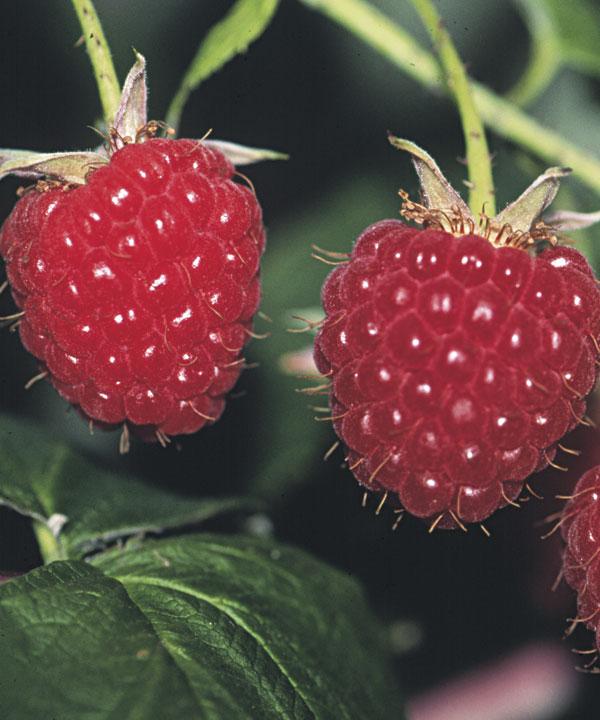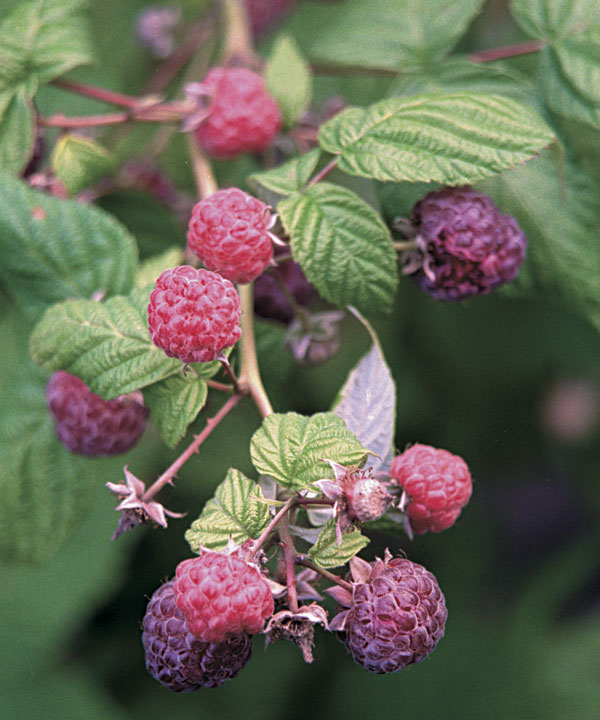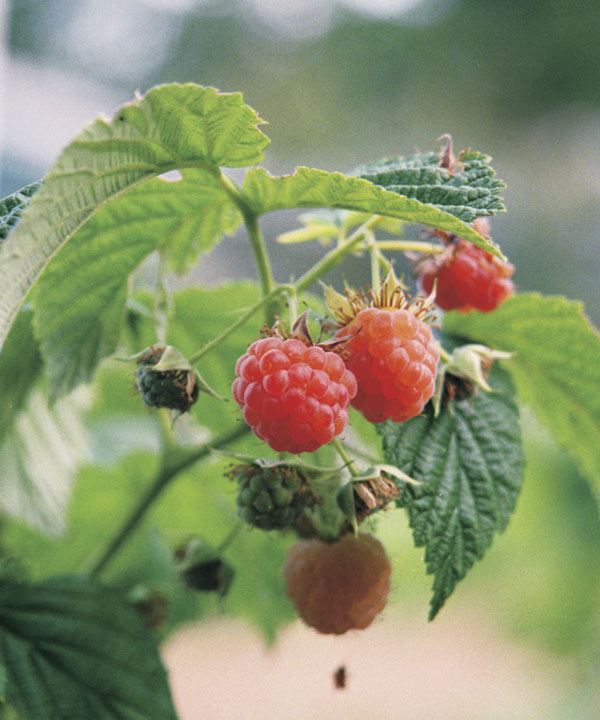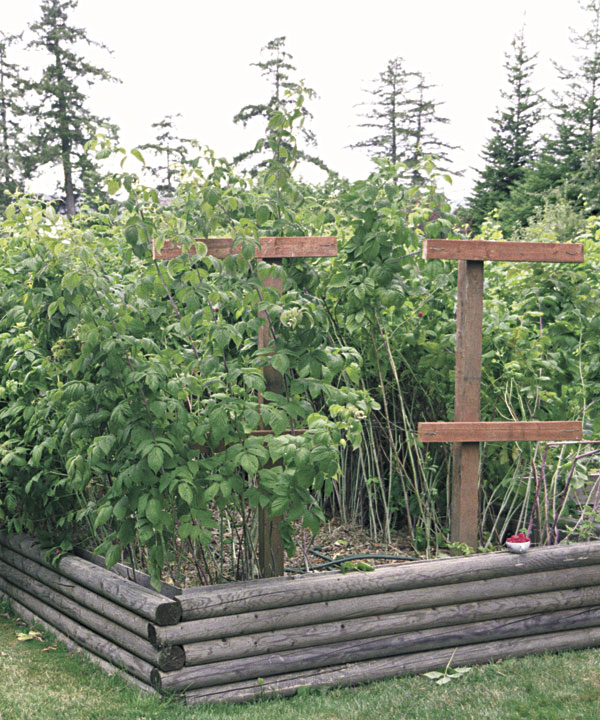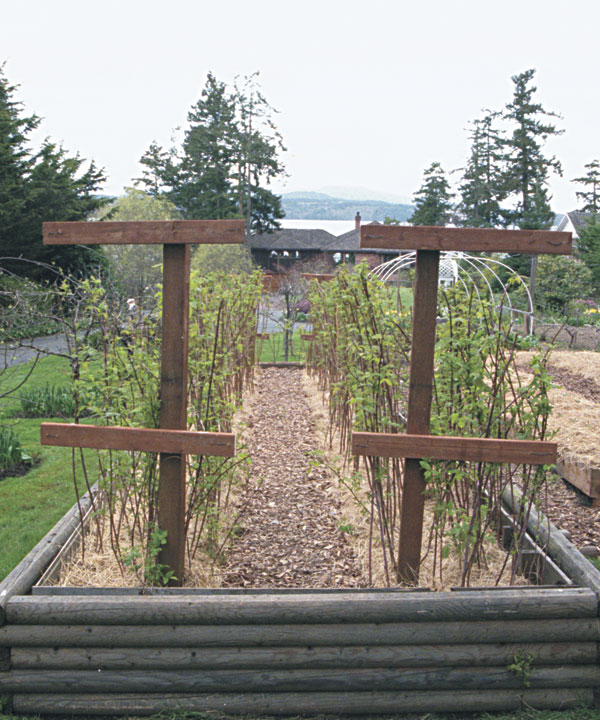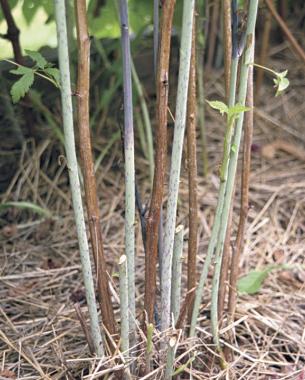You have to pick often to keep up with everbearing raspberries, though it's a welcome task. The author's canes grow to more than 7 feet tall every year.You may think the sheer gustatory pleasure of wolfing down ripe, juicy raspberries, whose flavor explodes in your mouth, is reason enough to grow them. Well, think again. Raspberries are not just another tasty berry; they are loaded with healthful attributes. They're high in fiber and contain vitamin A, folate, antioxidants, and numerous minerals; the juice contains vitamin C; and those sometimes-annoying little seeds contain vitamin E. And, of course, if you have a raspberry patch, you have endless dessert possibilities.
The key elements to raspberry success are careful selection of plant type, a good solid trellising system, and husbandry techniques that match the needs of the plant. Once everything is in place, your raspberry patch will provide you with many years of satisfaction.
Subscribe to Fine Gardening magazine to learn more about growing your own fruit. In fact, you’ll find instruction and inspiration for gardeners of every skill level.
Why choose an everbearing variety?We chose a classically red, everbearing variety called 'Summit', after asking our local agriculture office which raspberries are recommended for our area. We also taste-tested berries from local berry farms (an important step) to determine our favorite. We then shopped around for rooted canes that were certified disease-free.
Various raspberry cultivars will flourish from Zones 3 to 10. A little homework will get you, too, the right raspberries for your location. Take your time in selection, because raspberries come in varying shapes, sizes, and colors—red, purple, golden, white.
So why did we choose an everbearing variety? We love raspberries. We're willing to pick fruit every day until frost so we can eat our fill, give some to the neighbors, freeze some for winter, and leave the rest to the birds. Summer-bearing raspberries fruit for about a month, then it's all over (the fruit and the work) until next year. Everbearing raspberries, treated well, are just that—ever bearing. One mild winter we found a few ripe berries still hanging on in December. Once established, everbearing raspberries — called fall bearing by some—begin production in our area in July. The canes are usually so loaded down, they bend far over their support wires. Summer-bearing varieties generally fruit earlier, usually by a few weeks, so we also planted a few bushes of wine-red 'Brandywine' to enjoy while we wait for the heavier-producing main crop. For variety, we added the yellow-tinged 'Golden', which is everbearing. Other similar varieties are 'Fall Gold', 'Golden Summit', and 'Golden Harvest'.
The key elements to raspberry success are careful selection of plant type, a good solid trellising system, and husbandry techniques that match the needs of the plant. Once everything is in place, your raspberry patch will provide you with many years of satisfaction.
Subscribe to Fine Gardening magazine to learn more about growing your own fruit. In fact, you’ll find instruction and inspiration for gardeners of every skill level.
Why choose an everbearing variety?We chose a classically red, everbearing variety called 'Summit', after asking our local agriculture office which raspberries are recommended for our area. We also taste-tested berries from local berry farms (an important step) to determine our favorite. We then shopped around for rooted canes that were certified disease-free.
Various raspberry cultivars will flourish from Zones 3 to 10. A little homework will get you, too, the right raspberries for your location. Take your time in selection, because raspberries come in varying shapes, sizes, and colors—red, purple, golden, white.
So why did we choose an everbearing variety? We love raspberries. We're willing to pick fruit every day until frost so we can eat our fill, give some to the neighbors, freeze some for winter, and leave the rest to the birds. Summer-bearing raspberries fruit for about a month, then it's all over (the fruit and the work) until next year. Everbearing raspberries, treated well, are just that—ever bearing. One mild winter we found a few ripe berries still hanging on in December. Once established, everbearing raspberries — called fall bearing by some—begin production in our area in July. The canes are usually so loaded down, they bend far over their support wires. Summer-bearing varieties generally fruit earlier, usually by a few weeks, so we also planted a few bushes of wine-red 'Brandywine' to enjoy while we wait for the heavier-producing main crop. For variety, we added the yellow-tinged 'Golden', which is everbearing. Other similar varieties are 'Fall Gold', 'Golden Summit', and 'Golden Harvest'.
How many plants, and how big a patch?Raspberries multiply precociously, prodigiously, and prolifically. If you plant one cane this year, you will have a dozen or more in the same spot next year. Raspberries are joyfully exuberant about procreating by underground runners, poking up impressive numbers of healthy new plants all around your original patch. I don't consider this to be a problem, though, because one whack of the hoe takes care of them. You can also present them to a friend or use them to extend your patch.
Our two-row raspberry patch is 7 feet wide by 33 feet long. If I were to do it all over again, it would be 9 or 10 feet wide to allow more elbowroom for picking between the rows. We have 3 feet between rows, which is just barely enough. Four to 6 feet would be better.
Raised beds eliminate root rot
Our two-row raspberry patch is 7 feet wide by 33 feet long. If I were to do it all over again, it would be 9 or 10 feet wide to allow more elbowroom for picking between the rows. We have 3 feet between rows, which is just barely enough. Four to 6 feet would be better.
Raised beds eliminate root rot
Raspberry plants hate wet feet, and they are gross feeders. We addressed these two critical points by building a 20-inch-high raised bed and filling it with a mixture of four-fifths good garden topsoil blended with about one-fifth sand, peat, and well-rotted manure. If, like us, you have acidic soil, you will also need to add some lime, because raspberries prefer a soil pH of around 6.0. We left one end of the box open to allow easy access with our wheelbarrows, then closed it in when the box was full. This job can be done in the fall, so you are ready to plant, come spring.
If you have rich, deep soil that drains well year-round, you can simply plant your raspberries in a permanent garden site. Not us. The Pacific Northwest gets rain all winter, and many gardeners lose raspberries to root rot because they make the mistake of planting their raspberries' fussy little toes directly in the ground, which is often soggy clay covered with a skim of topsoil. We also experience a two-month drought most summers. Raised beds allow us to have deep soil that holds moisture evenly yet drains well.
It is important that you do not establish your raspberry patch in an area where you have recently grown tomatoes, peppers, or potatoes, to avoid verticillium wilt, which these vegetables can carry, and raspberries can catch.
More on raised beds
On our sister site, VegetableGardener.com , we have many articles and videos on building raised beds . We also have a raised bed gallery , with most of the photos posted by site members. Check them out for design and construction ideas.
Spring is the best time to plant
The best time to find plants, early spring, is also the best time to plant them, although you can put raspberries in anytime in the summer if you come into some healthy gift plants. Spring plants will establish better, though, and may well give you a few berries their first summer.
I soak bare-root plants in a half-strength solution of vitamin B1 growth stimulant (1/2 teaspoon per quart water) for about six hours (see Give your rootstock a healthy start). Don't delay planting. The small plants will not stand for soaking longer than a day in the B1 solution, and they will die quickly with dry roots. Should you receive dormant bare-root plants by mail before you are ready to plant, put them in the fridge to keep them dormant.
If you have rich, deep soil that drains well year-round, you can simply plant your raspberries in a permanent garden site. Not us. The Pacific Northwest gets rain all winter, and many gardeners lose raspberries to root rot because they make the mistake of planting their raspberries' fussy little toes directly in the ground, which is often soggy clay covered with a skim of topsoil. We also experience a two-month drought most summers. Raised beds allow us to have deep soil that holds moisture evenly yet drains well.
It is important that you do not establish your raspberry patch in an area where you have recently grown tomatoes, peppers, or potatoes, to avoid verticillium wilt, which these vegetables can carry, and raspberries can catch.
More on raised beds
On our sister site, VegetableGardener.com , we have many articles and videos on building raised beds . We also have a raised bed gallery , with most of the photos posted by site members. Check them out for design and construction ideas.
Spring is the best time to plant
The best time to find plants, early spring, is also the best time to plant them, although you can put raspberries in anytime in the summer if you come into some healthy gift plants. Spring plants will establish better, though, and may well give you a few berries their first summer.
I soak bare-root plants in a half-strength solution of vitamin B1 growth stimulant (1/2 teaspoon per quart water) for about six hours (see Give your rootstock a healthy start). Don't delay planting. The small plants will not stand for soaking longer than a day in the B1 solution, and they will die quickly with dry roots. Should you receive dormant bare-root plants by mail before you are ready to plant, put them in the fridge to keep them dormant.
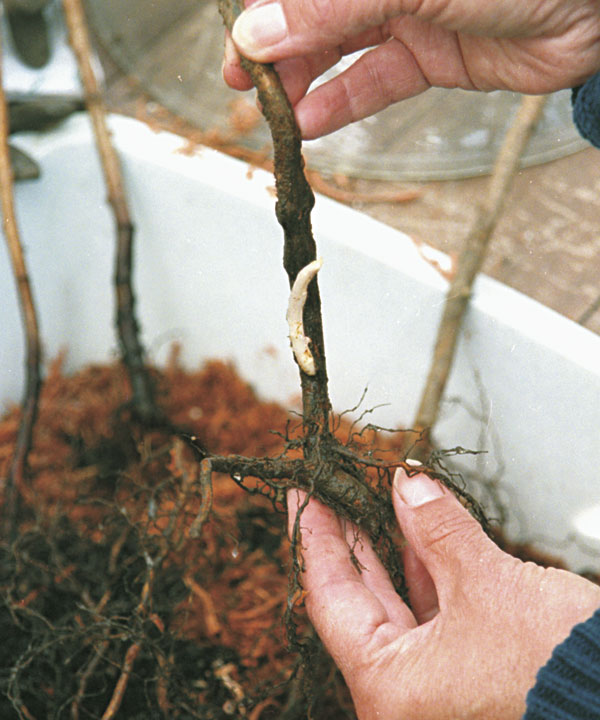
1. To plant raspberries in early spring, check bare-root plants for signs of life. The sprout on this stem ensures the likelihood of a take.
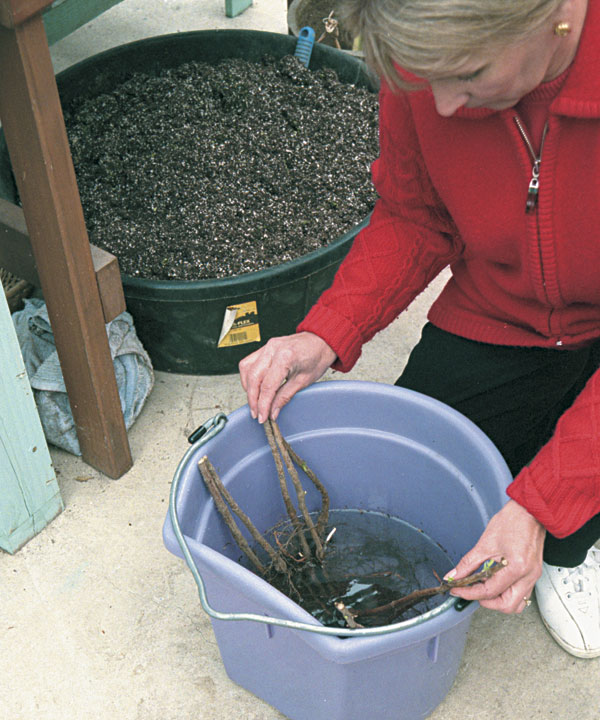
2. Soak bare-root plants in half-strength Vitamin B1 growth stimulant for about six hours.
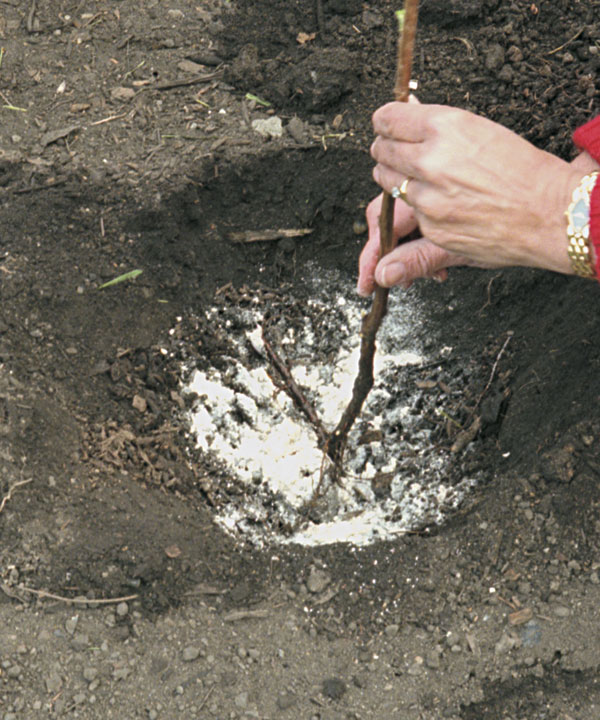
3. Plant in a 1-foot-deep, 1-foot-wide hole with a handful of rotted manure and organic fertilizer.
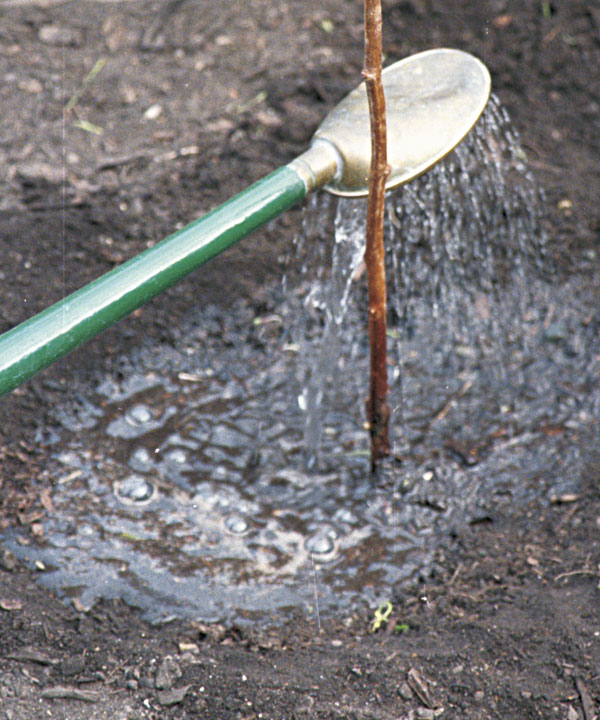
4. Water well.
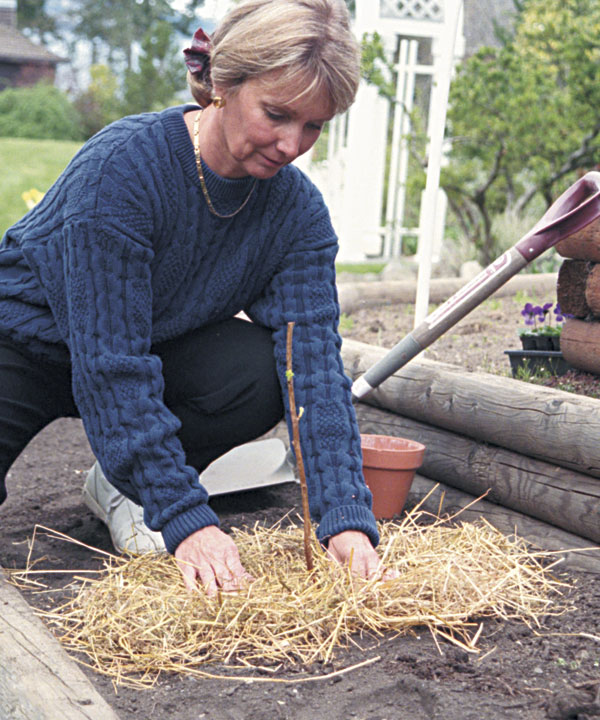
5. Mulch to retain moisture.
Have on hand some well-rotted manure, mushroom manure, or compost; organic fertilizer (see Organic fertilizer mix for raspberries), or 4-20-20; a water source; and some mulch. We use straw for mulch, but other materials will do just fine. I know a man who uses ripped-up newspaper.
Dig a hole 1 foot deep and wide per plant. In our case, we set the plants 3 feet apart in the row. Put a handful each of rotted manure and fertilizer in the hole. Add some water, pop the plant in, then carefully tuck the soil around and over its spread roots to make a small depression or basin at the surface, a place for rainfall to accumulate. Sprinkle some more rotted manure in this depression to provide a jump start for growth, then cover the ground around the plants with your mulch — no more than 3 inches deep. We laid landscape cloth over our path between the rows and covered it with wood chips. Drip irrigation is the ideal way to water raspberries, and this is the easiest time to install it.
Organic fertilizer mix for raspberriesI
make this up each year in a big rubber horse-feeding trough. If you use this mix just before your raspberries blossom, reduce the amount of canola/fish meal by half (to 2 parts), as the plants need less nitrogen then.
Dig a hole 1 foot deep and wide per plant. In our case, we set the plants 3 feet apart in the row. Put a handful each of rotted manure and fertilizer in the hole. Add some water, pop the plant in, then carefully tuck the soil around and over its spread roots to make a small depression or basin at the surface, a place for rainfall to accumulate. Sprinkle some more rotted manure in this depression to provide a jump start for growth, then cover the ground around the plants with your mulch — no more than 3 inches deep. We laid landscape cloth over our path between the rows and covered it with wood chips. Drip irrigation is the ideal way to water raspberries, and this is the easiest time to install it.
Organic fertilizer mix for raspberriesI
make this up each year in a big rubber horse-feeding trough. If you use this mix just before your raspberries blossom, reduce the amount of canola/fish meal by half (to 2 parts), as the plants need less nitrogen then.
- 4 parts canola seed meal or fish meal
- 1 part dolomitic lime (offsets the acidity of the seed meal)
- 1 part rock phosphate or 1/2 part bone meal
- 1 part kelp meal
A raspberry plant laden with fruit is top-heavy and needs support to keep it from falling over. Because we wanted our raspberry patch to last a long time, we began with a formal support system. At the end of each row of raspberries, we buried a 6-foot post 1 foot in the ground. Across the top and middle of each post, we fastened 30-inch crossbars with sturdy screws. We then stretched lengths of 16-gauge wire from the ends of each crossbar. In the beginning, we used only the top wire, but we found that some of the plants bearing fruit would fall over before they ever got to the top wire, so we added a second tier of wires about 2 feet off the ground. Sometimes the wires stretch from the weight of the plants and fruit, so we tighten them in early spring when we are pruning.
Pruning for a long harvest season
The smooth green 1-year-old canes and the rougher brown 2-year-old canes are easy to tell apart. Each spring, 1-year-old canes are trimmed back to below the fruiting area, and 2-year-old canes are removed completely.The main purpose of pruning is to get rid of older canes in favor of newer canes that will produce fruit. In late summer, some of your newly planted canes will begin to fruit at the top of the cane and continue into the fall. In the early spring of the following year, while the plants are still dormant, it's time to prune these now 1-year-old canes, and here is where we do something special.
The common method of pruning everbearing raspberries is simply to cut all of the canes down to about 1 inch from the ground. Though it's an easy way to go, this method eliminates the July crop. Fruiting doesn't begin until early fall, the reason some raspberry growers call everbearing raspberries "fall bearing." (This method is useful, however, if a disease has developed in your patch.)
Instead, the first spring, we cut the 1-year-old canes back to below the fruiting area, level with the top support wire. These shortened canes begin fruiting in July. In the meantime, leafy new canes, called primocanes, grow rapidly up from between the old canes. These new canes will flower and fruit later in the summer. We thin them out and clear away those suckers that popped up around the patch. The following spring, we remove the 2-year-old canes completely to make room for new growth, cutting them off at the ground, and we trim back the 1-year-old canes. We usually top-dress our raspberry patch with well-rotted manure and berry fertilizer in early spring. You can also prune summer-fruiting varieties using this method.
Damp in summer, dry in winter
To keep your plants healthy and productive, make sure they don't dry out in the summer. Remember: damp in summer, dry in winter. Spread straw or other mulch around the roots to help keep in an adequate supply of moisture. If you don't have a drip system, a soaker hose used for an hour or two each week should do the trick. In subsequent years, remember to top-dress the freshly pruned plants with several inches of well-rotted manure or compost, fertilizer, and, if necessary, a sprinkling of lime.
Raspberry plants need a significant amount of nitrogen to grow to their full 6 or 7 feet, but you should stop pushing high-nitrogen fertilizer on them as fruiting time approaches. At this time, the plants must concentrate on producing fruit instead of leaves. Using the homemade organic fertilizer on the facing page allows the plants to receive the nutrients they need when they need them.
We have found our raspberries to be remarkably free of pests and diseases. This is a good thing, because we are not fond of pesticides (or bugs). Some of the critters that can attack raspberries are nematodes, root or bud weevils, aphids, fruit worms, and crown borers. This latter problem involves maggots girdling the emerging canes, which may then break off at soil level or produce a poor crop. If you cut the canes to the ground, you can confound the borers and avoid drenching the root zone with an insecticide.
Pruning for a long harvest season
The smooth green 1-year-old canes and the rougher brown 2-year-old canes are easy to tell apart. Each spring, 1-year-old canes are trimmed back to below the fruiting area, and 2-year-old canes are removed completely.The main purpose of pruning is to get rid of older canes in favor of newer canes that will produce fruit. In late summer, some of your newly planted canes will begin to fruit at the top of the cane and continue into the fall. In the early spring of the following year, while the plants are still dormant, it's time to prune these now 1-year-old canes, and here is where we do something special.
The common method of pruning everbearing raspberries is simply to cut all of the canes down to about 1 inch from the ground. Though it's an easy way to go, this method eliminates the July crop. Fruiting doesn't begin until early fall, the reason some raspberry growers call everbearing raspberries "fall bearing." (This method is useful, however, if a disease has developed in your patch.)
Instead, the first spring, we cut the 1-year-old canes back to below the fruiting area, level with the top support wire. These shortened canes begin fruiting in July. In the meantime, leafy new canes, called primocanes, grow rapidly up from between the old canes. These new canes will flower and fruit later in the summer. We thin them out and clear away those suckers that popped up around the patch. The following spring, we remove the 2-year-old canes completely to make room for new growth, cutting them off at the ground, and we trim back the 1-year-old canes. We usually top-dress our raspberry patch with well-rotted manure and berry fertilizer in early spring. You can also prune summer-fruiting varieties using this method.
Damp in summer, dry in winter
To keep your plants healthy and productive, make sure they don't dry out in the summer. Remember: damp in summer, dry in winter. Spread straw or other mulch around the roots to help keep in an adequate supply of moisture. If you don't have a drip system, a soaker hose used for an hour or two each week should do the trick. In subsequent years, remember to top-dress the freshly pruned plants with several inches of well-rotted manure or compost, fertilizer, and, if necessary, a sprinkling of lime.
Raspberry plants need a significant amount of nitrogen to grow to their full 6 or 7 feet, but you should stop pushing high-nitrogen fertilizer on them as fruiting time approaches. At this time, the plants must concentrate on producing fruit instead of leaves. Using the homemade organic fertilizer on the facing page allows the plants to receive the nutrients they need when they need them.
We have found our raspberries to be remarkably free of pests and diseases. This is a good thing, because we are not fond of pesticides (or bugs). Some of the critters that can attack raspberries are nematodes, root or bud weevils, aphids, fruit worms, and crown borers. This latter problem involves maggots girdling the emerging canes, which may then break off at soil level or produce a poor crop. If you cut the canes to the ground, you can confound the borers and avoid drenching the root zone with an insecticide.
The smooth green 1-year-old canes and the rougher brown 2-year-old canes are easy to tell apart. Each spring, 1-year-old canes are trimmed back to below the fruiting area, and 2-year-old canes are removed completely.
A few diseases you may encounter are fruit rot, root rot, and spur blight. Fruit rot is a fungus that sets up housekeeping when canes are too crowded. The remedy is to prune for openness and to pick frequently in wet weather. Avoid overhead watering and prune out fruiting canes after harvest. Root rot results in the sudden death of the plant right after flowering, when the weather turns warm. The only remedy is to plant resistant varieties in friable, well-drained, rich soil. Spur blight shows up as dark chocolate-colored blotches on primocanes in mid-summer to fall when humidity is high. Infected areas on overwintered canes are silver gray and produce millions of spores. Lime-sulphur solution applied as a dormant spray and good air circulation provide adequate prevention.
On the flip side of pest control, we have encouraged healthy pollination in our raspberry patch by building a simple home for orchard mason bees, which we attached to one of the trellis poles. It's just a length of 4×4 with 5/16-inch holes drilled in it and an overhanging shingle for a roof; the orchard bees take up residence in the holes and proceed to do their thing.
More on growing berries…
Raspberries aren't the only berries you can grow in a home garden.For information on growing and using all kinds of berries, see VegetableGardener.com.
What to do with all those berries?I acquired my picking skills early. The eldest of five prairie farm kids, I had many domestic duties, including picking wild berries. "Never eat them until you are finished picking," was my mother's strict rule, and it is still a good one.
We eat them as desserts of all kinds, ranging from ice cream topped with berries or berries topped with ice cream and a mint leaf, to fancy cakes layered with mashed berries and chocolate and decorated with wild abandon. We make bumbleberry pies from a mixture of our own summer fruits. We also freeze great quantities of raspberries to remind us in the winter that summer once existed and will again.
How to Freeze Raspberries
Freezing raspberries is easy. Simply spread clean, firm berries on a cookie sheet and pop it in the freezer. When frozen, the berries roll nicely into ziplock bags. The sweetest berries are from the heat of summer. They will keep until the following summer and are sheer ambrosia on pancakes or waffles. And all of the options that were open to you when they were fresh are still there. You can still, for example, make raspberry vinegar with frozen raspberries, and you can spread sound berries over a salad to give it a special zing, certain to bring raves.
Raspberries keep well in the fridge for a few days, especially if you have picked them cleanly and discarded any mushy ones. An ice cream pail or any other plastic container with its lid on is all you need.
I don't can raspberries, but some people do. Instead, I mix them with pulp from the golden plums that grow on our ancient trees to make a jewel-toned jelly. Raspberries also make a great sauce, which can be frozen and used hot as the crowning touch on a simple dessert, or cold as a coulis. Raspberry juice can be mixed with soda to make a refreshing drink. The possibilities are endless. You can even ignore my mother's rule and pop them in your mouth as you pick them.
On the flip side of pest control, we have encouraged healthy pollination in our raspberry patch by building a simple home for orchard mason bees, which we attached to one of the trellis poles. It's just a length of 4×4 with 5/16-inch holes drilled in it and an overhanging shingle for a roof; the orchard bees take up residence in the holes and proceed to do their thing.
More on growing berries…
Raspberries aren't the only berries you can grow in a home garden.For information on growing and using all kinds of berries, see VegetableGardener.com.
What to do with all those berries?I acquired my picking skills early. The eldest of five prairie farm kids, I had many domestic duties, including picking wild berries. "Never eat them until you are finished picking," was my mother's strict rule, and it is still a good one.
We eat them as desserts of all kinds, ranging from ice cream topped with berries or berries topped with ice cream and a mint leaf, to fancy cakes layered with mashed berries and chocolate and decorated with wild abandon. We make bumbleberry pies from a mixture of our own summer fruits. We also freeze great quantities of raspberries to remind us in the winter that summer once existed and will again.
How to Freeze Raspberries
Freezing raspberries is easy. Simply spread clean, firm berries on a cookie sheet and pop it in the freezer. When frozen, the berries roll nicely into ziplock bags. The sweetest berries are from the heat of summer. They will keep until the following summer and are sheer ambrosia on pancakes or waffles. And all of the options that were open to you when they were fresh are still there. You can still, for example, make raspberry vinegar with frozen raspberries, and you can spread sound berries over a salad to give it a special zing, certain to bring raves.
Raspberries keep well in the fridge for a few days, especially if you have picked them cleanly and discarded any mushy ones. An ice cream pail or any other plastic container with its lid on is all you need.
I don't can raspberries, but some people do. Instead, I mix them with pulp from the golden plums that grow on our ancient trees to make a jewel-toned jelly. Raspberries also make a great sauce, which can be frozen and used hot as the crowning touch on a simple dessert, or cold as a coulis. Raspberry juice can be mixed with soda to make a refreshing drink. The possibilities are endless. You can even ignore my mother's rule and pop them in your mouth as you pick them.
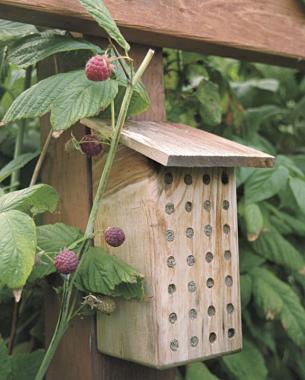
To ensure pollination of your raspberries, build a simple orchard mason bee house by drilling holes in a 4×4 and giving it a shingle-roof overhang. Secure the house to a sunny trellis pole, and the bees will come.
